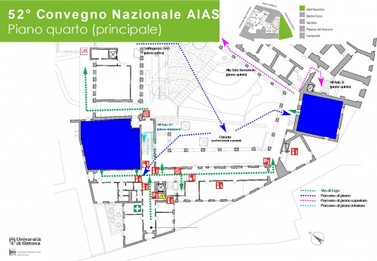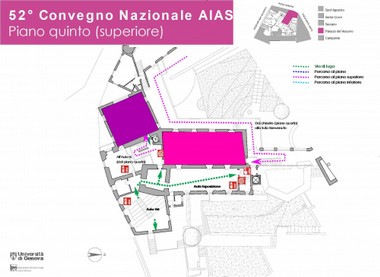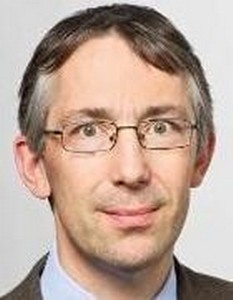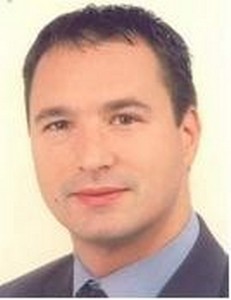Programma dei lavori
Le informazioni sul programma sono in aggiornamento continuo. Si prega di visitare spesso la pagina per gli ultimi aggiornamenti o modifiche.
MERCOLEDI' 6 SETTEMBRE | ||||
12:00-14:30 | REGISTRAZIONE | |||
14:30-16:30 | TECNICHE DI GIUNZIONE | DINAMICA | MECCANICA DEI MATERIALI I | PROGETTAZIONE MECCANICA I |
16:30-17:00 | Coffee break | |||
17:00-17:30 | Apertura dei lavori | |||
17:30-18:10 | Keynote lecture - Aula Magna Chiesa di S. Salvatore | |||
18:10-18:50 | Plenary lecture - Aula Magna Chiesa di S. Salvatore | |||
20:00-23:00 | Welcome Cocktail presso il Galata Museo del Mare | |||
GIOVEDI' 7 SETTEMBRE | ||||
08:30-10:30 | COMPOSITI I | BIOMECCANICA I | MECCANICA DEI MATERIALI II | PROGETTAZIONE MECCANICA II |
10:30-11:00 | Coffee break | |||
11:00-13:00 | COMPOSITI II | BIOMECCANICA II | MECCANICA DEI MATERIALI III | XTREMA I |
13:00-14:30 | Lunch | |||
14:30-16:00 | FERROVIARIO | ADDITIVE MANUFACTURING I | FATICA E FRATTURA I | XTREMA II |
16:00-16:30 | Coffee break | |||
16:30-17:10 | Plenary lecture - Aula Magna Chiesa di S. Salvatore | |||
17:10-18:00 | Assemblea soci AIAS | |||
18:00-19:00 | Elezioni per il rinnovo degli organi | |||
20:30-23:30 | Cena sociale Presso Palazzo Ducale | |||
VENERDI' 8 SETTEMBRE | ||||
08:30-10:30 | COMPOSITI III | ADDITIVE MANUFACTURING II | MODELLAZIONE I | AUTOMOTIVE I |
10:30-11:00 | Coffee break | |||
11:00-13:00 | MEAS I | ADDITIVE MANUFACTURING III | FATICA E FRATTURA II | AUTOMOTIVE I |
13:00-14:30 | Lunch | |||
14:30-16:00 | MEAS II | CURCULAR DESIGN I | FATICA E FRATTURA III | MECCANICA SPERIMENTALE I |
16:00-16:30 | Coffee break | |||
16:30-17:30 | CIRCULAR DESIGN II | |||
17:30-18:00 | Chiusura dei lavori - Aula Magna Chiesa di S. Salvatore | |||
Posizione aule
| Aula Magna "San Salvatore" | Piazza Sarzano | |
| 4° PIANO Aula 5H - 4° piano Aula 4H - 4° piano | Via di Santa Croce, 8 |  |
| 5° PIANO Aula Benvenuto Aula 5L | Via di Santa Croce, 8 |  |
Per essere sicuro di vedere gli ultimi aggiornamenti sul programma, ed evitare di visualizzare la copia della pagina presente nella cache del tuo browser:
- Browser Windows e Linux: CTRL + F5.
- Apple Safari: SHIFT + pulsante della barra degli strumenti Reload
- Chrome e Firefox per Mac: CMD + SHIFT + R.
MERCOLEDI' 6 SETTEMBRE 2023
16:30 -17:00 Coffee Break
17:30-18:10 Keynote Lecture: Prof. Enrico Giovannini, Università Di Roma Tor Vergata
18:10-18:50 Plenary Lecture: Prof. Fabian Duddeck, Technische Universität München
20:30 Cocktail di benvenuto
GIOVEDI' 7 SETTEMBRE 2023
16:00 -16:30 Coffee Break
16:30-17:10 Plenary Lecture: Dr. Alexander Vostner , ITER - Challenges in the Structural Analysis Design of the ITER Magnet System
17:10-18:00 Assemblea dei Soci AIAS
18:00-19:00 Elezioni per il rinnovo degli organi
20:30 Cena sociale
VENERDI' 8 SETTEMBRE 2022
18:00 Chiusura dei lavori
Plenary lectures
 | Prof. Enrico Giovannini — Biografia: Enrico Giovannini (Roma, 6 giugno 1957) è un economista e statistico italiano, dal 13 febbraio 2021 al 22 ottobre 2022 è stato Ministro delle infrastrutture e della mobilità sostenibili nel governo Draghi e dal 28 aprile 2013 al 22 febbraio 2014 è stato Ministro del lavoro e delle politiche sociali del governo Letta. È professore ordinario di Statistica economica all'Università degli Studi di Roma Tor Vergata, dove insegna Statistica e Analisi e politiche per lo sviluppo sostenibile. È co-fondatore e Direttore scientifico dell'Alleanza Italiana per lo Sviluppo Sostenibile[4] (ASviS), una rete di oltre 300 soggetti della società civile italiana. Collabora con il Joint Research Centre della Commissione Europea. È stato Chief Statistician dell'OCSE dal 2001 all'agosto 2009 e presidente dell'Istat dall'agosto 2009 all'aprile 2013. È stato docente di Sviluppo sostenibile presso l'Università LUISS e la Scuola Nazionale di Amministrazione (SNA), Senior Fellow della LUISS School of European Political Economy[5], Associate Senior Research Fellow del Centre for European Policy Studies[6]. Fino a gennaio 2021 è stato presidente dell’European Statistical Governance Advisory Board[7] (ESGAB), l’organismo che supervisiona il funzionamento del Sistema Statistico Europeo, membro del Comitato esecutivo del Club di Roma, del Global Happiness Council[8], presidente della Commissione per la redazione della Relazione sull’economia non osservata e sull’evasione fiscale e contributiva[9] del Ministero dell'Economia e delle Finanze e membro del Comitato Scientifico dell'Ufficio Parlamentare di Bilancio (UPB)[10]. Nel 2014 il Segretario Generale delle Nazioni Unite Ban Ki-moon lo nomina Co-chair dell'"Independent Expert Advisory Group on the Data Revolution for Sustainable Development", il quale ha pubblicato il Rapporto "A World That Counts"[11]. Negli ultimi anni è stato membro della Global Commission on the Future of Work[12] dell'Organizzazione internazionale del lavoro, dell’High-Level Expert Group on the Measurement of Economic Performance and Social Progress (HLEG) [13] istituito dall’OCSE e della Independent Commission for Sustainable Equality (ICSE)[14]. È autore di oltre 120 articoli, di sette libri su temi statistici, economici e politici, alcuni tradotti in altre lingue, e di rapporti di commissioni internazionali sul futuro del lavoro e sulle politiche europee per lo sviluppo sostenibile. Ha inoltre curato otto libri, alcuni pubblicati in lingua inglese. Nell’ottobre del 2014 è stato nominato “Cavaliere di Gran Croce al Merito della Repubblica”. Ha ricevuto numerosi premi per la sua attività scientifica e politica attribuiti da istituzioni nazionali e internazionali. Nel gennaio 2023 ha ricevuto dalla Scuola Universitaria Superiore di Pavia IUSS il dottorato di ricerca honoris causa in "Sustainable Development and Climate Change" | |
 | Prof. Fabian Duddeck—Technische Universität München Machine Learning Techniques for Crash Optimisation Biografia: Professor Duddeck (*1965) conducts research on the development of numerical methods for the simulation and optimization of structures, focusing on methods for parameter, shape, topology, layout, and material optimization of nonlinear and dynamic problems (acoustics, crash). New approaches for material modeling (composites, biomaterials) and the evaluation of aleatory and epistemic uncertainties (flexibility, robustness, reliability) complement these activities, often in the context of multi-physics and multi-disciplinary applications. Prof. Duddeck studied civil engineering at TUM, earning his Diplom (1990) and Dr.-Ing. in Mechanics (1997) there. After a postdoc period at Ecole Polytechnique/Palaiseau and at TUM, he acquired his postdoctoral teaching qualification (Habilitation) in 2001. He later held an R&D position in industry (BMW) and served as lecturer at TUM. In 2005/6, he served as Reader (Associate Professor) at Queen Mary University of London (QMUL) and as Maître de Conférences at Ecole des Ponts ParisTech (ENPC). In 2010, he was appointed Professor for Computational Mechanics at TUM. | |
 | Dr. Alexander Vostner / ITER - Challenges in the Structural Analysis Design of the ITER Magnet System ABSTRACT: In the frame of an international collaboration the European Union, the People’s Republic of China, the Republic of India, Japan, the Republic of Korea and the Russian Federation have decided to build ITER, the International Thermonuclear Experimental Reactor. It is the world largest fusion machine and presently being constructed in Europe in the South of France. ITER is based on magnetic confinement and comprises the largest magnets ever built. The main magnet systems are the Toroidal Field (TF) Coils, the Poloidal Field (PF), the Central Solenoid (CS) and the Correction Coils (CC). Those are superconducting magnets operating at 4 K with a total stored energy of 51 GJ. The combination of high magnetic fields above 10 T, coil currents up to 70 kA and dimensions of 13x9 m leads to enormous loads and forces. The design of coils to withstand such loads in a nuclear environment is very challenging in particular as the structural integrity has to be ensured for extreme load cases such as seismic events or loss of coolant accidents. The second major magnet system of ITER are the In-Vessel Coils (IVCs) which are water-cooled Cu coils situated inside the vacuum vessel. There are 2 sets of IVCs magnets, the Vertical Stability (VS) coils and the Edge Localised Mode (ELM) coils. Both magnets are essential for the control and stability of the ITER plasma. Given their vicinity to the fusion plasma the IVCs are exposed to high radiation loads and temperatures. This harsh environment and coil requirements such as peak currents up to 90 kA had to be considered in the design and qualification of the IVCs. All ITER magnet systems have completed their design phase and are in production. The design evolution from the structural analysis point of view will be presented for the main coil systems. Focus are given on the challenges and their resolution together with lessons learned for future design activities of similar components. | |


